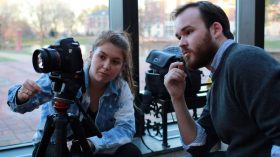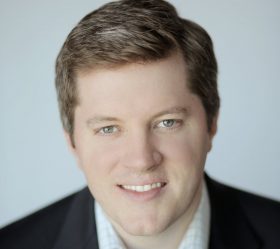While experts agree television will continue to be a fixture in our lives, the model of how content is delivered—and who is creating it—is continually evolving.

They sketched their ideas for the series, which tells the story of two friends navigating college life, and assembled a team of talented Elon friends: Will Lee ’15 as director, Cappy Leonard ’15 as director of photography and Delaney McHugo ’15 as producer. In February, “Lightweights” was launched on Vimeo and YouTube, where people can watch the series online for free. “Most students our age consume the majority of television on their laptops, so it made sense for us to use the Internet to reach our peers,” says Boyd, a media arts and entertainment graduate who co-stars with Weis in the lead roles in the series. “We felt doing a Web series would give us flexibility in content and release schedule, and be accessible to a wide range of people.”
Indeed, television as we know it is changing. In the era of Netflix, YouTube and video on demand, the days of the prime-time lineup, when people planned their evening based on the airing of their favorite TV shows, are a thing of the past. The rise of readily available digital content, free or paid, has made it possible for people to cut the cord from television subscription services and watch their favorite shows whenever and wherever they want. This is leading the major players, TV networks and local stations, to question their business models while also opening the door for independent content creators to get a piece of the market.
A content revolution
According to a 2014 survey about viewing habits by the media and strategic research consulting firm Frank N. Magid Associates, an increasing number of Americans are watching videos on their laptops and smartphones—or plug their TV into a broadband connection to search for content—rather than watching traditional cable channels, leaving advertisers out of the equation.

Content providers, MacKenzie says, are looking at all available options to distribute content in the various ways it can be consumed: over-the-top (online streaming), over-the-air (antenna) and subscription television (cable, satellite). Take CBS, for example, which gets a piece of the over-the-top market with its “CBS All Access” online service and inclusion in Sling TV, DISH Network’s digital streaming service for cord cutters, while still participating with all cable companies. “They are experimenting to see what’s the way to make the most money,” MacKenzie says. “Is that the right mix? It takes time to know for sure.”
Part of what is in turmoil is the definition of television itself: is it a device or a piece of content? Usually, MacKenzie says, when we talk about TV programming, it’s in the traditional sense of 30- or 60-minute shows that follow a schedule. But video content takes all shapes and forms. Netflix’s “House of Cards,” whose episodes run about 53 minutes, is considered by people to be a TV show even though it doesn’t follow that formula. The conflict is in the business model. “That’s where the tension is created,” MacKenzie says. “If you are an ad-supported network like FOX and you want to run ‘House of Cards,’ it needs to be 45 minutes to fit in a window. So if you’re [executive producer] David Fincher and go to Netflix, which says ‘I don’t care how long it is,’ you don’t have to edit it to fit.”

“I often tell my students this is similar to the environment I encountered when I graduated from my undergraduate communication program,” Gibson says, describing a time when FM radio was being forced to no longer carry the same programming as AM stations. “We were trying to figure out what would work: album sides in their entirety; only four commercial breaks in an hour; three songs in a row without speaking. It was exciting! We were making it up as we went along, and if something worked we kept it.
“Part of the joy was that no one, absolutely no one, knew what was going to work, so we were free to experiment and try and fail and try again.”
This setup has a great appeal for content creators who want to maintain complete creative control. It’s also a catalyst for young professionals who are trying to break into a saturated market. “In the Digital Age, everyone has the ability to produce content at rates that were never possible before. This has created an influx in the amount of information that people feel like they need to process in order to stay up to date,” Leonard says. “It is the biggest reason why people are seeking out short-form content that they can process quickly and efficiently.”

It’s a reflection of what they’ve learned at Elon. Having taken countless master classes with alumni, casting directors and professional artists, Weis says she learned early on to take ownership of her career and the importance of creating original work to fulfill her artistry. Boyd, who together with Lee and Leonard participated in the Elon in LA Program, was also encouraged by her professors to take responsibility for her own learning, something she believes will translate well when navigating today’s changing media landscape.
Like many other professors, Gibson has for years been incorporating webisodic projects in addition to the more traditional half-hour live and pre-produced shows, public service announcements and other assignments. “In communications we’ve always said that no medium has replaced that which came before it, but rather modified it,” Gibson says. “This may be the moment when that changes. If my students have spent their developmental years not watching television on a particular night at a specified time, will they suddenly decide, ‘Yes, I need to watch CBS at 9 p.m. on Sunday evening’? Networks and local stations are going to need to reinvent how they do business.”
A changing model
While viewership of television in the legacy, appointment-based viewing model is starting to erode, TV content is more popular than ever before, and therefore, a profitable venture. From a business perspective, traditional television—think cable, satellite and the major networks accessible over the air—generates more than $70 billion a year, says c, vice president of broadcast solutions at Sorenson Media.
However, Lusk says that model is antiquated. “While consumers, viewers and advertisers have changed their behaviors, we still basically operate local television the same,” he adds. “Overall, content creation, distribution and measurement has evolved dramatically on all screens except for television.”
Most stations, for instance, still depend on Nielsen ratings, a system that has remained relatively unchanged since its inception. And while the system has gone from using diaries to electronic meters when measuring viewership, Lusk says, the sample sizes have not grown and the rating/shares of adults 18-49 are still the currency of the day. “Selling broad audiences to advertisers built on a faith-based measurement system is a major long-term weakness in a digitally connected world where we can measure actual media consumption live, in real time, down to the individual person on all other screens,” he says.

“One way of thinking about it is to picture the ‘glass’ in the TV set being able to detect what is on the screen at any given time. Once a TV knows what is on the screen, it can figure out what channel is being watched,” he adds. “With that, we can determine what program is being watched, and for how long.”
At Sorenson, Lusk works to aggregate this second-by-second viewership data across smart TVs at scale. “We can then use these millions of TV sets across the country to provide deeper, more accurate measurement of television consumption regardless of how the program found its way into the home,” he says.
He argues that by empowering stations to deliver interactive viewing experiences to their viewers, they can engage with their viewers within the television sets themselves without having to drive people to another device, such as a smartphone or computer. “Local TV stations have to evolve their business models, and it starts with taking back control of measurement,” Lusk says. “Once stations have control of their own measurement, they have the runway to evolve their thinking about how they program to their markets.”
Regardless of what shape the new business model takes, one thing is for sure: television is not going anywhere. “I see television evolving,” MacKenzie says. “I see the word meaning something different.” As it’s currently configured, television itself is the greatest marketing tool for TV programming. “Networks in some ways may evolve into very high-end marketing machines to create awareness and demand of content being delivered in different ways/platforms.”
Quality will likely play a large role in the future of television. Gibson points to YouTube, which has developed a compression scheme for delivering higher definition than the standard 720 or 1080 pixels being used by broadcast television, adding that Apple and others, too, have developed new technology that promises to be capable of ultra high resolution. Even if all the production technology is in place, Gibson says, television stations, having recently invested millions in going high definition, would not generate higher than standard resolution content. “This is where the networks will lose to other content providers unless they develop their own over-the-top delivery,” he adds.
There is also the issue of regulation, MacKenzie says, as the Federal Communications Commission and other regulatory organizations decide how the Internet is to be used. Whether or not the signal comes through a coax cable, the availability and ubiquity of Wi-Fi will be a large part of that discussion. “All of these things in the ecosystem will have a hand in determining what happens,” he says.
In the future, there is no doubt that more content is going to be streamed, he adds. Take Comcast Corp., which in July announced its own alternative for cord cutters called “Stream.” The streaming service, which the company will roll out next year, promises access to several channels for a monthly fee, though it’s only available to its broadband customers. Whether this model will succeed is anybody’s guess. MacKenzie says there is a lot of research being conducted right now, monitoring what’s happening every day, measuring people’s awareness and attitudes of various technologies.
At the end of the day, he adds, it’s not all about following people’s behaviors but rather how television is monetized. “Follow the money. That will dictate the future of television.”
Ask the expert
As vice president of broadcast solutions at Sorenson Media, Travis Lusk ’05 leads a team of broadcast television professionals across the country toward the “future” of television. “My group serves as the boots-on-the-ground team that manages the products and services we provide to local broadcast TV stations,” he says. We asked him to explain the different ways people are consuming content.
The three main ways that television ends up on the “glass” of your TV set:
Over-the-Air (OTA). Most people think of this as the old fashioned rabbit ears on top of a set. Conceptually that’s still the case, but today’s digital antennas are small and slick. You actually can tuck them behind the set or on your wall so you won’t even see it. They are capable of receiving full high-definition programming with crystal clear quality.
Multi-channel Video Programming Distributor (MVPD). These are the cable and satellite companies. Think Comcast, Time Warner, DISH, etc.
Over-the-Top (OTT). Traditionally, these are external devices that collect or stream TV content over the Internet to a TV set. Think Apple TV, Roku, and to some degree, Chromecast. However, this term is somewhat dated because it now includes television sets that are themselves able to connect directly to the Internet and stream/download content. OTT devices were designed to make “dumb” TVs into “smart” TVs, but virtually all TV manufacturers now offer the same streaming services natively in the set. We are likely to see large parts of the “external device” portion of the OTT market fade away in favor of the simplicity of a single device—the TV.
Thinking about cutting the cord?
Here are some things to consider before you say good-bye to your cable or satellite subscription.
Do you mostly watch local channels?
If so, all you need is a digital antenna. Depending on your location and the range of your antenna, you can pick up upwards of 15 channels over the air for free, including all four major networks (ABC, CBS, NBC and FOX) as well as other popular selections (PBS, the CW).
Movies anyone?
If you are more of a movie buff, there are free options out there, such as Crackle, though these typically include some ads. If you want a greater variety of uninterrupted entertainment, you can subscribe to streaming services such as Amazon Prime, Hulu Plus, Netflix or HBO Now.
What about sports?
You can watch some sports on the major networks over the air but if you don’t want to miss a single event, you can subscribe to streaming services that cover specific sports: MLB.TV, NHL GameCenter Live, NBA League Pass and MLS Live. You might also want to consider getting Sling TV, which gives you access to ESPN and ESPN2 in addition to other movie channels.
How fast is your Internet connection?
Make sure you have enough bandwidth for your TV and movie content before you cut the cord. Netflix suggests download speeds of 5 megabits per second for streaming HD-quality video, but 15 megabits per second and higher is considered optimal, particularly for multiple viewers/devices.
What hardware do I need?
You can stream most online programming on your computer, smartphone or tablet via websites and apps. But if you want to bring online content directly to your TV, you’d need a smart TV or a TV connected to an Internet-capable device such as a game console or Blu-ray player, or a set-top box such as Apple TV, Roku or PlayStation Vue.
Sources: Digital Trends, Netflix, Tom’s Guide


